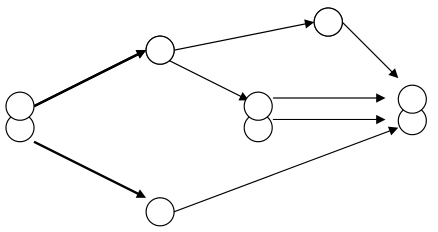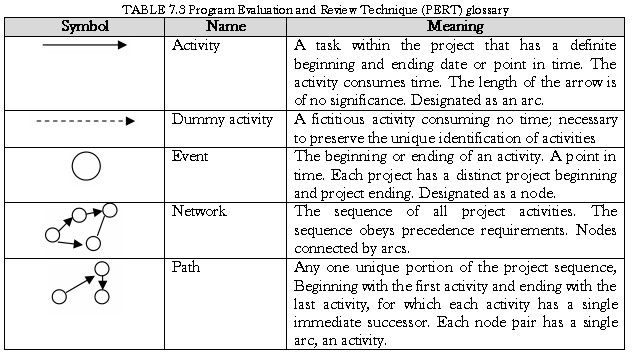Development of PERT: In 1958 the U.S. Navy developed Program Evaluation and Review Technique (PERT) for planning and control of the Polaris nuclear submarine project. The results of using PERT in that application, in which some 3,000 contractors were involved, is generally reported to have reduced by two years the project completion time for the Polaris project. In both government and industry today PERT is still widely used.

Figure 7.2: Network of nodes and arcs
A similar modeling approach called the Critical Path Method (CPM) is also used by business and government. Since CPM and PERT are nearly equivalent, we will concentrate only on PERT.
Application of PERT: First we should clarify the conditions under which PERT may be appropriately used. If your situation lacks the following features, PERT will yield little benefit
- First, the project must be one whose activities clearly are distinct and separable.
- Second, the project and activities must all have clear starting and ending dates.
- Third, the project must not be complicated by too many interrelated tasks.
- Fourth, the project must be one whose activities afford alternative sequencing and timing.
Language of PERT: The PERT language comprises simple symbols and terms. As described in Figure 7.2, key symbol are those for activity, dummy activity, event, and critical path of the network. Since the critical path requires the longest time through the network, management should watch it most closely to avoid unnecessary project delays.
Logic of PERT How does PERT work? It works by following these steps:
- Clearly identify all activities in the project.
- Identify the precedence requirements of the activities.
- Diagram the precedence requirements as a sequence of activities.
- Estimate the time each activity will take.
- Calculate the critical path and other project performance criteria, creating the schedule and plan for subsequent control criteria, creating the schedule and plan for subsequent control.
- Reevaluate and revise as experience dictates.
Time estimates are obtained from either past data or from people experienced in a particular activity. Optimistic t0, pessimistic tp, and most likely tm times must be estimated so that the expected (average) time te can be calculated from the following equation.
(t0 + 4tm + tp)
te=6


